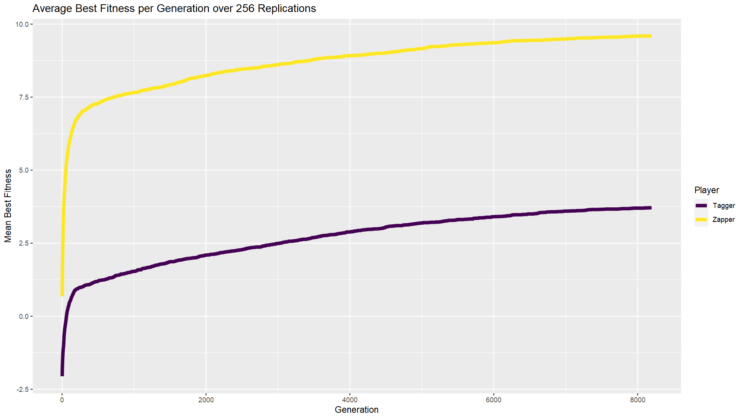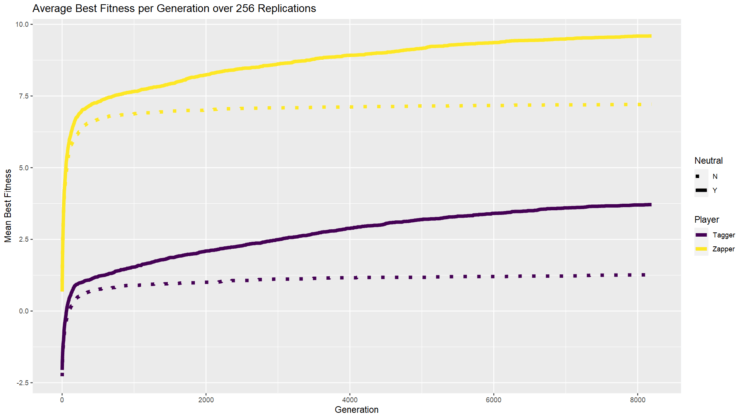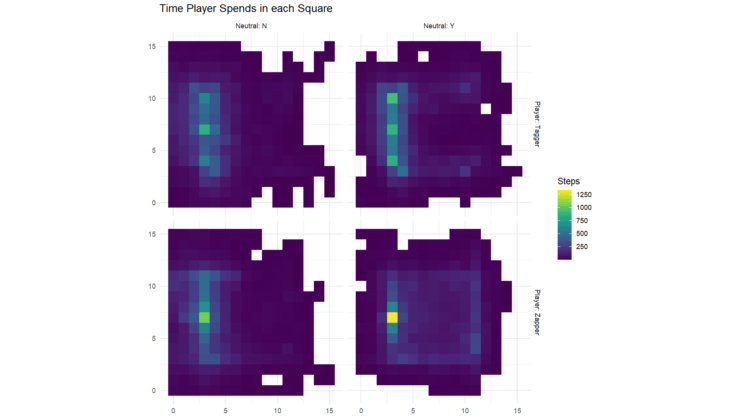
 )
)Previously in the Quandary Den, I gave you a chance to do some evolutionary artificial life experiments for yourself. I hope you got an opportunity to at least run a couple of different rounds with the simulation. As I mentioned last week, I think simulations like this are a good way to gain experience and build intuition for phenomena we can’t otherwise engage with in daily life. Few of us get to do evolutionary biology in the lab or the field, and some experiments are not possible for anyone due to pragmatic or ethical limitations. But many of us with access to computer resources can play and experiment with simulations like the Quandary Den. In doing so, perhaps you might discover that while evolution is an approach for solving problems, it does not solve all problems equally well.
We met two kinds of players for the Quandary Den: zappers and taggers. Both start in the same position and have to achieve the same goal of scoring four ‘hits’ on each of four opponents without getting hit themselves. Zappers can use a laser gun to zap from afar, while taggers have to get close. Perhaps you discovered that taggers were less likely to achieve that goal, if given the same number of moves (genome length) and same number of generations to evolve a solution (see chart below). If that was obvious to you from the nature of the task and their playing styles without experimenting, great! You likely already have some intuition for how to think about evolutionary questions. But it’s still good to get confirmation, because sometimes science confounds our intuitions. And if that result wasn’t obvious to you, great! You got to discover something new and build your evolutionary intuition.

One way to think about why the tagger cannot evolve a solution as quickly is in terms of random walks. Normally, when one goes for a walk, one either has a destination in mind, or perhaps a route to go out and back to the start. Each step is then chosen to get closer to the destination or follow the route. A random walk does not follow a particular route. Instead, at each step a random direction is chosen from the available options. A random walk could actually be a physical walk around a physical space. Or it could be a metaphorical walk through an abstract space. The Quandary Den involves a little of both. In each round, the program simulates a player actually moving in a two-dimensional physical space; if the player’s genome is chosen at random then that movement will be a random walk. And indeed, when we made a chart of where the player goes without selection, what we saw is typical of a random walk, with the player spending more time close to the start and decreasing amounts of time in squares as they get further from the start.
At the same time, we are also simulating a metaphorical walk through the abstract space of all possible genomes. This space has many dimensions (one per each genome position) with limited positions (the possible instructions). Mutations represent steps in random directions in this space. If there is no selection, these mutation steps will produce an unbiased random walk in that metaphorical genome space. Introducing selection is like adding partitions & walls to our space that prevent the random walker from choosing certain directions at certain places. In some cases selection can also act like a door that can only open from one side, allowing a walker through in one direction but preventing them from going back. We might imagine a genome space with lots of tight passages and many doors; in that case, even a random walker might make rapid progress along the passages because they don’t have other options. In an open room with just external walls, a random walker will meander more.
While the simulated Quandary Den space is the same for both players, the genome spaces they can explore have different walls and doors. The space for taggers has fewer walls and doors, so more time is spent meandering. Thinking back to our exploration-with-feedback summary of evolution, that means taggers have to do more exploring before they get any feedback. In evolutionary biology, exploration without feedback is called neutral evolution, involving neutral mutations. Neutral mutations are ones which have no impact on fitness (e.g. the score in the game). For example, if a tagger has a mutation that takes their path next to an opponent when before they did not get next to that opponent, but there is no “tag” instruction while the player is in that space, that mutation alone won’t change their score. It is neutral.

If they amount to aimless meandering, can neutral mutations ever contribute to evolution? Well, let’s see what happens if we don’t allow neutral mutations to accumulate. We aren’t eliminating them entirely; we are just changing the selection rules slightly. Before, we would mutate a genome and keep it as long as it didn’t decrease the fitness. Instead, we can change the rule so that we only keep a genome if it increases fitness; otherwise we go back to the previous version and introduce new mutations. As the chart above shows, when we don’t allow neutral mutations to accumulate (dotted lines), both player types tend to get lower scores. How can this be?

Seeing where the players spend their time can help us answer that question. In the chart above, the left column shows results without accumulating neutral mutations, and the right column shows results with them. The bottom row, for the zapper, has the clearest outcomes. Without accumulating neutral mutations, the players tend to get stuck on the left side of the room where they started, leaving them with fewer places from which to zap the right-side opponents. That’s because just taking steps across the room do not add to the score by themselves, so mutations that enable crossing will be neutral. If we don’t allow neutral mutations to accumulate, several mutations have to happen in a single generation to facilitate crossing the room. If we do allow them to accumulate, then a trip across the room can build up over several generations. Thus while a full account of evolution needs to include exploration and feedback, not all exploration needs immediate feedback to contribute.
I hope you’ve found these simple experiments and the chance to run your own to be helpful. We’re going to take a break from the Quandary Den for a few weeks, but we’ll come back. In the mean time, I’d love to hear how your own exploration with the program is going. Do you have any suggestions for improvements? Do you have questions you’d like to answer or hypotheses you’d like to test that the current version doesn’t permit? Do you feel like you were thrown into the deep end and want some more guidance on how to design experiments and interpret the results? The comment section awaits any feedback along those lines.
Andy has worn many hats in his life. He knows this is a dreadfully clichéd notion, but since it is also literally true he uses it anyway. Among his current metaphorical hats: husband of one wife, father of two teenagers, reader of science fiction and science fact, enthusiast of contemporary symphonic music, and chief science officer. Previous metaphorical hats include: comp bio postdoc, molecular biology grad student, InterVarsity chapter president (that one came with a literal hat), music store clerk, house painter, and mosquito trapper. Among his more unique literal hats: British bobby, captain’s hats (of varying levels of authenticity) of several specific vessels, a deerstalker from 221B Baker St, and a railroad engineer’s cap. His monthly Science in Review is drawn from his weekly Science Corner posts — Wednesdays, 8am (Eastern) on the Emerging Scholars Network Blog. His book Faith across the Multiverse is available from Hendrickson.

Leave a Reply